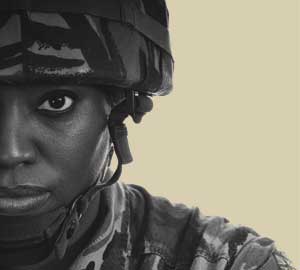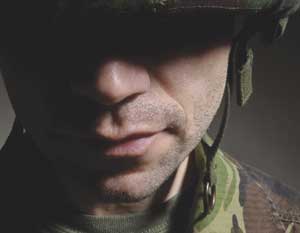Lessons Learned from the Good Samaritan

“War is eternity jammed into frantic minutes that will fill a lifetime with dreams and nightmares.” —John Cory
One afternoon in the late 1980s I was teaching at the local community college when one of my best friends on the faculty walked into my office. Chris was an English teacher and Vietnam War combat veteran, and he came to me with a troubled look on his face. After some small talk, he said, “I had to leave my class early. I’m having a flashback!” My office must have seemed a safe refuge and I, as his friend—a psychology instructor and Vietnam-era Army veteran—would understand. Observing his distant expression, I understood only my helplessness. We sat, mostly in silence, for several minutes until his flashback subsided. If I was any help at all, it was not in anything I said but in what I did not say. He did not come seeking help, only my presence, an anchor to keep him moored in the here-and-now. My friend was experiencing a symptom of post-traumatic stress disorder.
Post-traumatic stress disorder (PTSD) is the emotional ghost of a life-threatening event. It lingers in the shadows of the victim’s mind looking for an opportunity to poke a tormenting finger into any secure sanctuary sought by the victim. In sleep, it is a nightmare; awake, it is a struggle to contain that nightmare. Those who strive to help the victim are often left feeling helpless as the victim is pulled ever deeper into an emotional abyss that is cognitively, perceptually, and emotionally off-limits to others. Quakers have an esteemed history of reaching out to victims of war to assist in the healing process. Post-traumatic stress disorder, however, is so complex that it defies the normal helping process. Not only does PTSD defy it, sometimes that helping process makes the trauma worse. If we, as a religious community, want to help veterans with PTSD, we must first appreciate the physical, emotional, and mental vicissitudes of this destructive disorder; if not, we run the risk of heaping more trauma onto the traumatized.
Post-traumatic stress disorder is most often associated with military combat. The first study of PTSD was Jacob Mendes Da Costa’s “On Irritable Heart” (1871), which described stress symptoms in American Civil War veterans. Other wars in our history have given this syndrome other names: shell shock, combat fatigue, psychoneurosis. Following the Vietnam War, the medical community was confronted by large numbers of veterans displaying a cluster of biopsychosocial symptoms that did not fit into any one comprehensive diagnosis. It was not until 1980 that this cluster was formally recognized as a diagnosable syndrome and given the name post-traumatic stress disorder.
Medically, post-traumatic stress disorder is classified as an anxiety disorder, but it also reveals itself as a dissociative disorder, a grief reaction, a behavioral disorder, and a neurobiological disorder. According to the American Psychological Association, it results from the following:
having experienced, witnessed, or being confronted with an event or events that involved actual or threatened exposure to death or serious injury, a threat to the physical integrity of self or others, or sexual violation resulting in intense fear, panic, hopelessness, or horror.
The recent wars in Afghanistan and Iraq have revealed a new area of combat related trauma known as moral injury. According to PTSD Research Quarterly, moral injury is defined as “an act of serious transgression that leads to serious inner conflict because the experience is at odds with core ethical and moral beliefs.” Moral injury is related to PTSD but is not a necessary component. Recent wars have also created an extremely high incidence of traumatic brain injuries (TBI), which is a result of a blow to the head that alters consciousness. TBI is not only devastating in its own right, but also increases the likelihood of PTSD.
Although PTSD is most often associated with war, statistically, this is misleading. Records indicate that some survivors of the 1666 Great Fire of London exhibited PTSD symptoms, so did survivors of Hurricane Katrina. According to the World Trade Center Health Registry, the attacks on 9/11 led to an estimated 70,000 persons developing PTSD symptoms. PTSD can be the result of any severe life-threatening event, from massive civilian catastrophes to the singularly personal, such as a near-fatal automobile accident; being a rescuer; or being a victim of child abuse, domestic violence, or sexual assault; even surviving breast cancer can bring it on. The National Institute of Mental Health estimates 7.7 million Americans are affected by PTSD. The singularly highest rate of PTSD is seen among rape victims; combat veterans; and physically assaulted women, mostly those in continuing domestic violence situations. The longevity of the wars in Afghanistan and Iraq will result in a large part of a generation being afflicted with PTSD. The cost for treatment is astronomical, but the cost in the loss of productive lives is reprehensible.
Why do some persons who experience a traumatic life-threatening event develop PTSD and others do not? There is no one determining factor. People have different dispositions and different developmental circumstances. Those who had adverse childhood experiences and grow up lacking social support may be more predisposed to developing PTSD. The magnitude of the stressor must also be taken into account: the greater the fear, the greater the likelihood of developing PTSD. If there is any one deciding factor, it is the post-traumatic experience: continued exposure, as in combat or domestic violence, and lack of the appropriate social support after the event.

- 25 percent of Iraq and Afghanistan veterans suffer from PTSD
- 5 percent more suffer from PTSD and TBI
- From 2004 to 2009, the Veterans Health Administration spent $1.1 billion for PTSD- and TBI-specific care
(Source: 2012 Congressional Budget Office Study)
Flashbacks and other symptoms
Although PTSD is characterized by a cluster of symptoms, there are some very specific characteristics that PTSD victims exhibit. Re-experiencing (distressing recollections, dreams, flashbacks) is a basic symptom in which the sufferer not only recalls but also relives the traumatic event, experiencing the same array of emotions of panic, fear, and hopelessness. Flashbacks are more than thoughts about what happened. The stored memories of the traumatic event cause the victim, like my friend Chris, to emotionally and cognitively relive the situation. Flashbacks are powerful because emotions are powerful memory generators.
In a traumatic event, all the accompanying emotions (the fear, anxiety, panic, and helplessness), as well as the sensory stimuli (the smells, sights, sounds) are rammed into a part of the brain, the limbic system, where they will reside permanently as a memory. From that moment on, any sensory experience similar to those experienced during the trauma (even a prayer prayed during the event) may trigger the traumatic memory and cause the victim to relive the terror once more. As for the moral injury, the long-term memory of what is right is confronted with a recent act of wrongdoing, requiring the victim to morally justify that action. These psychobiological conflicts are emotionally exhausting and lead to anxiety, depression, guilt, and despair.
In an effort to avoid anything that might trigger a memory or flashback, many victims will physically, socially, and emotionally withdraw from engagement with the world. Some, especially veterans, will find a place to live far away from neighbors; others will avoid social gatherings. Unemployment is preferable to any job where a sight, noise, or smell might cause a resurgence of traumatic emotions. Inability to work leads to poverty, which leads to homelessness—and both lead to further isolation.
Too often, PTSD victims will numb themselves in an attempt to blunt their anxiety. Alcohol and drug abuse runs two to three times higher than in the general population, with depression three to six times higher. These lead to higher rates of suicide. Some victims sublimate their anxiety into creative experiences such as working with victims, social work, political reform, or the arts. To deal with his anxiety, my friend combined the negative with the positive by smoking a couple packs of cigarettes a day and writing a riveting novel laced with anecdotes of his own combat experiences. He never intended to have it published. It was his way of dealing with his mental demons in a manner he could control. I knew to never ask Chris about his combat experiences, but through discussions of his writing, he could share them indirectly; in this format, he had control.
Many PTSD victims live in a continuous state of hyperarousal, that is, guardedness, lest they be attacked again or something trigger a flashback. This hyperarousal contributes to insomnia, irritability, outbursts of anger, and difficulty concentrating. All of these contribute to aggressive behaviors, domestic violence, divorce, unemployment, substance abuse, incarceration, guilt, homelessness, as well as distancing them from their spiritual potential. It also wears down the immune system, making PTSD victims more vulnerable to stress-related diseases such as type 2 diabetes and heart disease.
PTSD symptoms can start immediately after the event or surface intermittently. There may be no symptoms for weeks, months, or even years. What sort of stimuli can trigger an acute PTSD reaction? Sometimes nothing, it just spontaneously occurs. Witnessing or even hearing about another traumatic event; stress; a certain sight, sound, or smell; medical illness; any situation that makes the victim feel helpless; or loss of whatever coping mechanism the victim was using to survive—all, some, or none of these can send a PTSD sufferer into an emotional crisis.
There is no magic bullet for curing PTSD. For many victims the symptoms will resolve without treatment. For others, the disorder can be successfully treated by appropriate medical and psychological interventions. Those who think that a PTSD victim can willfully “just get over it” or “pray it away” should know that such expectations only heighten the victim’s anxiety and contribute to their suffering. The complexity of the disorder requires that all treatments be done by professional practitioners experienced in treating PTSD.

- Intrusive re-experiencing of trauma
- Avoidance of stimuli that might invite traumatic memories or experiences
- Numbing
- Hyperarousal
The religious community as Good Samaritan
If lack of appropriate social support after the traumatic event is a contributing factor in the duration and intensity of PTSD, then the religious community should focus on offering appropriate support. Along with the physical and emotional consequences, PTSD victims experience a moral anguish; they have been robbed of a belief, be it in the existence of goodness in the world, in themselves, or the goodness of a kind and merciful God. Victims may not find that God again until they see his goodness in action.
The religious community should serve as a bridge from evil to goodness. And what better model for that is there than the Good Samaritan (Luke 10: 29–37)? He provided the victim unconditional support—physical assistance, immediate medical care, lodging, and financial support—with no questions, no expectations, no advice, no admonishments to be more careful, no criticism of his behaviors.
In a world where tragedies are inevitable, PTSD reminds us of just how fragile we humans are and how much we need God’s and one another’s help. Spiritually, the religious community must be “the one to show mercy” (Luke 10:37). When traumatic victimization leads an individual to ask, “Where was and is the kind, merciful God?” it is a heart-rending and difficult question to answer, one too often answered with meaningless, patronizing platitudes. What has meaning is showing God’s immanence by offering good back into the victim’s life. Expect acceptance and avoidance of help as the victim’s anxiety level waxes and wanes, but be ever-forgiving and ever-present to help again.
Perhaps the most important role for the religious community is to speak truth to power and say, “Enough!” We can call for an end to the senseless wars, humiliation of women, and the diversion of finances from education and basic social needs. We can say “enough” to the rapacious military-industrial complex and the accumulation of wealth through exploitation. For Quakers, the peace testimony must garner more than a few paragraphs in our Faith and Practice; it must become part of our ongoing identity reflected in our actions.
Not too many years after that encounter in my office, Chris, then in his 40s, died of a heart attack. His death certificate lists the cause of death as a myocardial infarction. But he, along with thousands of others like him, before and since, was a casualty of war no less than if he had been shot through the heart in the jungles of Vietnam, the mountains of Afghanistan, or the deserts of Iraq. May they all rest in peace.

- Veterans Crisis Line: 1-800-273-8255
- “PTSD: A Growing Epidemic” (NIH MedlinePlus, Winter 2009 issue)
- U.S. Department of Veterans Affairs National Center for PTSD (ptsd.va.gov)




Comments on Friendsjournal.org may be used in the Forum of the print magazine and may be edited for length and clarity.